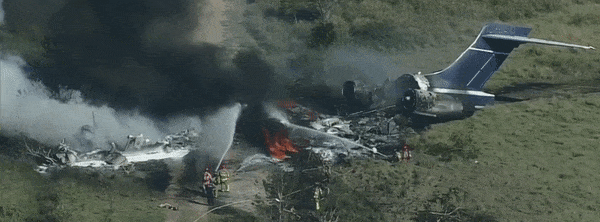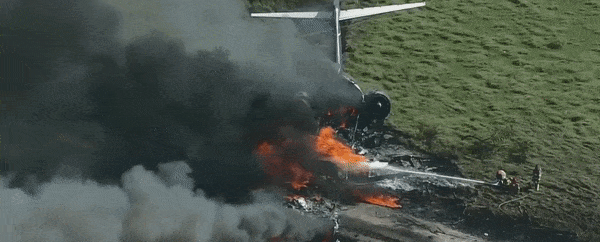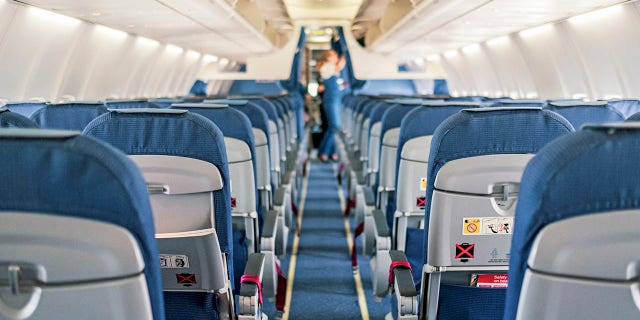The dramatic event of nearly two dozen people safely evacuating the passenger plane that crashed in Houston earlier this week has brought renewed attention to the survivability of air disasters.
Despite data from the National Transportation Safety Board indicating that the odds of becoming involved in a deadly plane crash remain overwhelmingly low, there are actions that passengers could take to further increase their chances of survival.
Here are four tips on how to survive a plane crash.

The aftermath of the plane crash Tuesday at Houston Executive Airport in Brookshire, Texas.
(Fox 26)
1) Sit close to the exits as ‘every second counts’ in the event of a disaster
Professor Ed Galea, a fire and evacuation expert and founding director of the Fire Safety Engineering Group at the University of Greenwich in London – which conducts research on the topic – told Fox News he’ll try to “get a seat as close to an exit as possible, preferably within nine seat rows of an exit” whenever he flies.
“Generally, there is no ‘safest’ seat on an aircraft during a crash. This is because each accident is different,” he said. “However, our research of past survivable aviation crashes suggests that you have a higher probability of surviving a fatal crash the closer you are seated to a serviceable exit.”
SURVIVORS OF TEXAS PLANE CRASH WERE HEADED TO ASTROS GAME IN BOSTON
He added, “This is because in an aviation crash, especially one involving a post-crash fire, every second counts, each second can literally make the difference between life and death.”

The McDonnell Douglas MD-87 had rolled through a fence and caught fire at the Houston Executive Airport, the FAA said.
(Fox 26)
2) Keep your shoes on in preparation for an escape
A plane crash will scatter items and luggage all over the cabin – and when that happens, you don’t want to be caught wearing only your socks, Galea said.
“Keep your shoes on for takeoff and landing. If you have to take off your shoes, wait until the aircraft has reached cruising altitude and make sure you put them back on before the aircraft starts the descent,” he went on.
“As a result of the crash, the aircraft cabin is likely to be full of debris, or even worse partially broken up,” Galea continued. “You don’t want to be making your way to the exit in bare feet.”
3) Recognize these seat belts aren’t exactly like the ones in your vehicle
Seat belts on planes serve the same purpose as those found in motor vehicles, but a key difference is the way in which they lock and release.
Plane seat belts release by pulling on a lever mechanism, while the ones used in vehicles release with the press of a button. Remembering that difference during your flight could buy valuable time to escape, according to Galea.

An empty airplane cabin interior. Professor Ed Galea recommends being aware of your surroundings before heading to your seat while boarding.
(iStock, File)
CLICK HERE TO GET THE FOX NEWS APP
“In an emergency situation, when your survival ‘flight’ mode instincts have kicked in and you are operating in ‘autopilot mode’ it is easy to lose precious seconds as you erroneously try to press the seat belt lever to release the seat belt – and every second counts,” he said.
“This type of behavior has actually been reported in previous aviation accidents and has even occurred to frequent flyers,” he added, noting that “due to operating a car seat belt hundreds of thousands of times in your life, you have trained your brain to react in this way.”
4) Take note of your surroundings while heading to your seat
Galea says before takeoff, it’s best to count the number of seat rows from yours to the exit — and that distance as well — in case the plane cabin fills up with smoke in the event of a crash.
“It may become difficult for you to see the exit, even if it is open, so you could walk/crawl past it,” he said. “Even if you are a frequent flyer, it is unlikely you will know the number and location of exits on the aircraft, let alone their location relative to your seating location.”
 Iktodaypk Latest international news, sport and comment
Iktodaypk Latest international news, sport and comment






